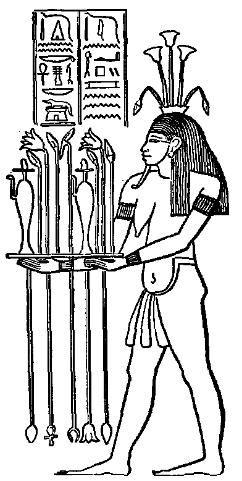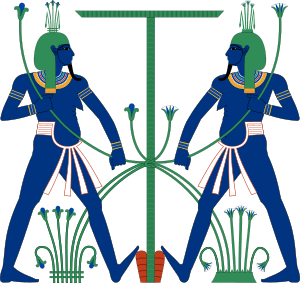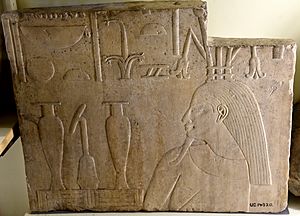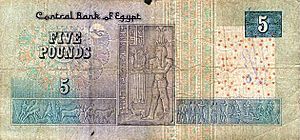Hapi (Nile god) facts for kids
Quick facts for kids Hapi |
|||||
|---|---|---|---|---|---|

Hapi, bearing offerings
|
|||||
| Name in hieroglyphs |
|
||||
| Major cult center | Elephantine | ||||
| Symbol | Lotus plant | ||||
Hapi was an important god in ancient Egyptian religion. He was known as the god of the yearly flooding of the Nile River. This flood was super important because it brought rich, fertile soil to the riverbanks. This soil helped the Egyptians grow all their crops.
People in ancient Egypt really celebrated Hapi. Some of his special names were "Lord of the Fish and Birds of the Marshes" and "Lord of the River Bringing Vegetation." Hapi is usually shown as a figure who looks both male and female. He has a big belly and large breasts, wears a loincloth, and a fake beard for ceremonies.
Contents
Hapi's Role and Beliefs
The yearly flooding of the Nile was sometimes called the Arrival of Hapi. This flood brought fertile soil to a desert land, so Hapi became a symbol of new life and growth. He was shown with large female breasts because he was believed to bring a rich and nourishing harvest.
Because he brought so much life, Hapi was sometimes called the "father of the gods." People thought of him as a caring father who helped keep the world balanced and orderly. It was believed that Hapi lived in a cave near the source of the Nile River, close to a city called Aswan.
Hapi's Main Worship Place
The main place where Hapi was worshipped was at the Elephantine island. This island was located at the First Cataract, which is a rocky part of the Nile River. Hapi's priests had special jobs. They performed rituals to make sure the annual flood happened at the right level.
At Elephantine, there was a special tool called a nilometer. This device measured how high the Nile's water level was. Hapi's priests watched it very carefully to predict the flood's level.
Hapi and Other Gods
Hapi was not seen as the god of the Nile River itself, but specifically of the flooding event. He was also considered a "friend of Geb," who was the Egyptian god of the earth. Hapi was also known as the "lord of Neper," the god of grain.
How Hapi Was Pictured
Even though Hapi was a male god and wore a fake beard, he was often shown with large breasts and a big stomach. These features represented how fertile and life-giving the Nile River was. He also usually had blue or green skin, which stood for water.
Hapi's Appearance in Different Regions
Hapi's other features changed depending on where in Egypt he was shown.
- In Lower Egypt, he was decorated with papyrus plants and surrounded by frogs. These were common in that area and were symbols of it.
- In Upper Egypt, the lotus flower and crocodiles were more common in the Nile. So, these became the symbols linked with Hapi there.
Hapi was often pictured carrying food offerings or pouring water from a jar called an amphora. Very rarely, he was shown as a hippopotamus.
Hapi as a Symbol of Unity
During the Nineteenth Dynasty, Hapi was often shown as a pair of figures. Each figure held and tied together the long stem of two plants. These plants stood for Upper and Lower Egypt. This image showed the two parts of the country being joined together around a hieroglyph that meant "union." This symbolic picture was often carved at the bottom of statues of the pharaohs.
Images for kids
-
Hapi is featured on the £E5 note.
See also
 In Spanish: Hapi para niños
In Spanish: Hapi para niños






